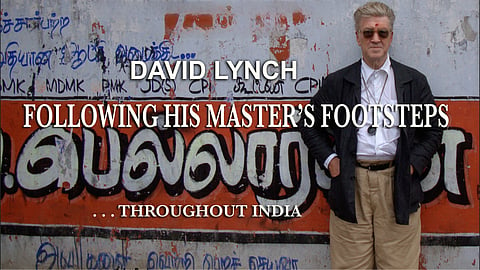
- HOMEGROWN WORLD
- #HGCREATORS
- #HGEXPLORE
- #HGVOICES
- #HGSHOP
- CAREERS
- ABOUT US
- CONTACT US

David Lynch’s work danced on the edge of reality and dreamscapes. With him, goes a singular voice in cinema. Known for reimagining the mundane and the obscure, Lynch’s creative universe was one of unparalleled depth. While much has been written about Eraserhead, Twin Peaks, Mulholland Drive, and Blue Velvet, perhaps no project reveals the man behind the myth more than 'It’s a Beautiful World'.
This is Lynch unplugged: not an auteur but a pilgrim following the footsteps of Maharishi Mahesh Yogi, the founder of Transcendental Meditation. With Richard Beymer behind the camera, Lynch in 2009 retraces the Maharishi’s spiritual journey across India in a ten-day whirlwind of temples, rivers, and ancient caves. The result was a film that, while not widely known, was quintessentially Lynchian — not because it was strange, but because it was sincere.
Watching It’s a Beautiful World is unlike anything else in Lynch’s world. It’s not fiction, but it feels mythical. The opening scene places Lynch in Trivandrum. Lynch’s work has always reflected an affinity for contrasts — light and shadow, innocence and depravity. Here, those contrasts are distilled into real life. In one sequence, he visits Jyotir Math, the ashram where Maharishi served his guru, Guru Dev.
The juxtaposition of the ancient and the ephemeral, the spiritual and the everyday, mirrored the dualities that defined his films. Perhaps that’s the key to understanding both Lynch’s films and his life. He sought truth in abstractions, not because he wanted to confuse us but because he wanted to show us the unseen forces that shape our lives. For Lynch, Transcendental Meditation was a way to access those forces.
What struck me most about It’s a Beautiful World was its humility. What could’ve easily been a documentary where Lynch dominates the frame, instead is a quiet meditation. In one of the most moving scenes, he stands in a small lecture hall at Allahabad University, where Maharishi studied physics as a young man. Lynch marvels at the idea that the founder of TM began his path in the world of science, using logic and reason as stepping stones.
Lynch’s reflections during the trip reveal the connection between his meditative practice and his creative process. TM, he believed, allowed him to access ideas. The documentary also carries Lynch’s characteristic attention to detail. When the camera follows him to Kanyakumari, where three oceans meet, the frame feels alive with meaning. You could almost believe this was a scene from one of his films, where the setting itself becomes a character.
Lynch once said that his films begin with a single idea — a fragment, a spark — that he builds upon until a world emerges. With It’s a Beautiful World, the spark was Maharishi’s vision of bliss as the essence of life. And Lynch follows it with the same devotion he gives to the characters in his scripts. But the film is not about enlightenment in the abstract. It’s about Lynch’s relationship to it. Here we see a man who has spent decades plumbing the depths of human fear and loneliness, finding solace in a practice that teaches stillness.
In the end, It’s a Beautiful World is not a perfect film. It’s uneven, at times meandering, and occasionally feels like an extended home movie. But it’s honest. And for David Lynch, honesty was always more important than perfection. Lynch’s passing leaves a void in cinema, but perhaps his greatest gift was showing us how to embrace the unknown. In a 2009 interview, he said of Maharishi: “He thought what he had to offer would be useful to humanity.” The same could be said of Lynch himself. He taught us that the nature of life is not always rational, not always linear, but always, in some way, wonderful.
David Lynch is gone, but the world he saw — the beautiful, strange, and infinite — remains.
If you enjoyed reading this, here's more from Homegrown:
From Historical Epics To Desi Horror: Our Pick Of Films To Watch In 2025
An Anurag Baruah Short Captures Mumbai's Dualities Through A Cab Ride Conversation
7 South-Asian Feature Films That Helped Shape The Diaspora’s Identity
